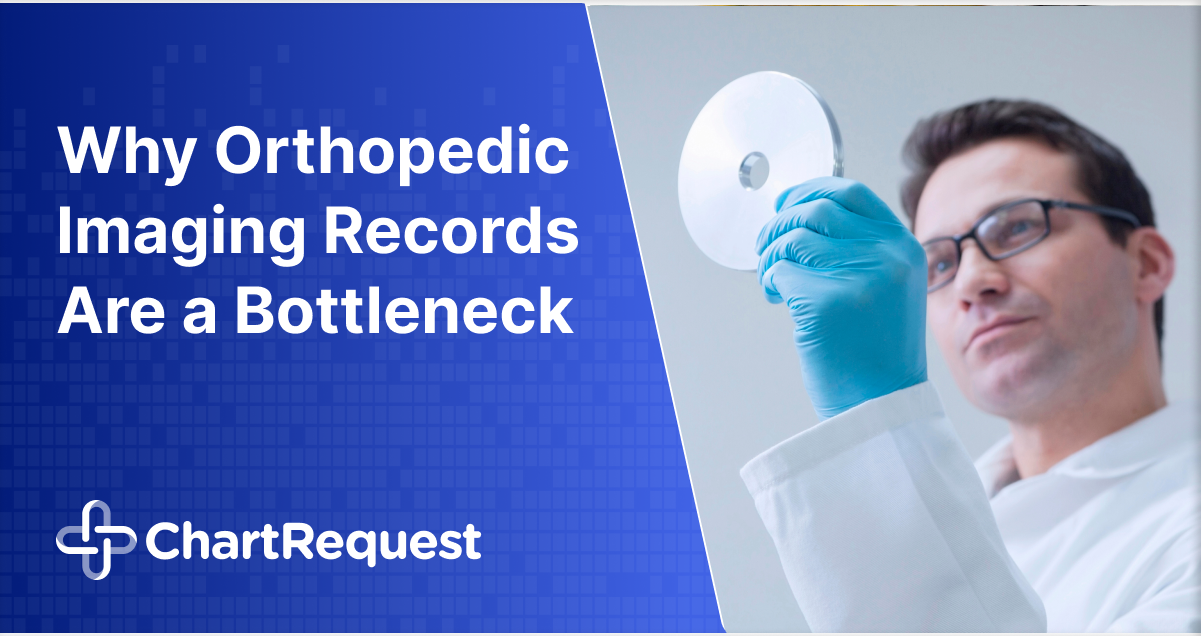Orthopedic imaging records can be immensely valuable for providers and third-party professionals alike, but sharing them with traditional methods has been an expensive bottleneck for decades.
From diagnosing torn ligaments to planning spinal fusions, MRIs, CT scans, and X-rays guide nearly every clinical decision. Yet in most orthopedic practices, imaging files are still burned to CDs and shipped through postal mail.
This delay doesn’t just burden staff with time-consuming administrative work; it introduces real operational and compliance risk.

Why Imaging Records Create Unique Workflow Challenges
Managing imaging records presents distinct challenges that go beyond standard medical documentation.
These records involve large, complex files that often require specialized systems and workflows. Without the right infrastructure, imaging fulfillment can slow down care delivery, burden staff, and increase the risk of delays or errors.
Key issues include:
Large File Sizes
High-resolution imaging modalities, such as MRI and CT scans, generate substantial data volumes. For instance, a single CT scan can exceed 30 megabytes, depending on the number of slices and resolution used.
These large file sizes complicate storage, transfer, and retrieval processes, especially when dealing with limited bandwidth or storage capacity.
PACS–EHR Integration Gaps
Picture Archiving and Communication Systems (PACS) and Electronic Health Records (EHR) often operate on different platforms, leading to integration challenges.
Compatibility issues between PACS and EHR systems, particularly when sourced from different vendors, can result in workflow disruptions and inefficiencies. This disconnect hampers seamless access to imaging data within patient records.
Reliance on Physical Media
Despite advancements in digital technology, many healthcare providers continue to use physical media like CDs for image distribution. This practice is not only outdated but also inefficient. Such reliance on physical media can delay record access and increase operational costs.
According to a 2021 article, Yale New Haven Health produced around 142,000 imaging CDs and DVDs in 2019. At an estimated $3.95 per disc, the organization spent nearly $550,000 before labor, retrieval, shipping, and delivery costs.
Orthopedic Imaging Record Metrics Are Difficult to Track
When imaging records are burned to CDs and sent through the mail, visibility disappears. You don’t know when or if the requestor receives the disc. There’s no way to confirm it reached the right person, whether it was misdelivered, or if it’s sitting unopened on someone’s desk.
This makes it nearly impossible to track fulfillment performance or troubleshoot delays.
Most orthopedic practices report average record turnaround time to leadership, but few separate imaging from the rest of their ROI workflow. This is despite imaging being one of the most complex and time-consuming parts of the process.
This lack of visibility can lead to:
- Missed bottlenecks and workflow delays.
- Limited ability to track failed deliveries.
- An incomplete audit trail to defend against compliance concerns.
Without knowing key imaging metrics for orthopedic practices like delivery speed, operations teams are left without a clear picture of performance or accountability.
How ChartRequest Fixes the Imaging Delivery Gap
Imaging fulfillment doesn’t need to be slow, manual, or stressful.
ChartRequestSelect is purpose-built to close the gaps that traditional imaging release methods create and automate the entire process. It helps your team move faster, stay compliant, and serve patients without added administrative strain.
Benefits include:
No file size limits. Whether you’re sharing a single X-ray or a full-body MRI series, ChartRequest can handle imaging files of any size. There’s no need to compress, split, or ship on physical media.
Works with any PACS or EHR. The platform is designed to integrate with your existing systems. Imaging files can be uploaded directly from any PACS, and the process works seamlessly alongside all major EHRs.
100% electronic delivery. You can eliminate the need to burn and mail discs. ChartRequestSelect delivers imaging records securely using encrypted, HIPAA-compliant systems. Every transfer is tracked, timestamped, and logged.
Reduces staff workload. From request intake to final delivery, the ChartRequest team handles the entire orthopedic imaging ROI process. This removes the need for manual logging, repeated follow-ups, or staff time.
No disc drive? No problem. Recipients get secure access to a built-in DICOM viewer. There are no downloads, installations, or special hardware needed. This ensures seamless access for patients, attorneys, and payors.
Orthopedic practices that switch to ChartRequestSelect can automate this outdated process at no cost and free up their teams to focus on higher-impact work.
A Better Imaging Experience for Referring Providers
Referring physicians don’t want to wait a week for a disc or call your practice multiple times to track down a file they never received. ChartRequest allows orthopedic practices to send MRIs, CTs, and X-rays to referring providers instantly.
This eliminates unnecessary admin effort and boosts referral coordination while putting patients at the center of the process.
- Specialists gain faster access to imaging, allowing them to prepare for consults more thoroughly
- Redundant testing is avoided, reducing cost and exposure for the patient
- Referral satisfaction improves, which strengthens provider relationships and supports long-term growth
Fast, reliable access to imaging improves workflows and helps ensure patients receive timely, informed care and the best outcomes possible.
Modernize Your Orthopedic Imaging Release Process
In orthopedics, imaging is more than a supplement to documentation. It’s central to diagnosis, consultations, and long-term care decisions. Yet in many practices, imaging release is still handled as a separate, manual process, disconnected from the broader ROI workflow.
The good news is you don’t need to overhaul your PACS or EHR to fix the problem.
You’ve already invested in imaging to support excellent care. Modernizing how you release it is the next step forward. ChartRequestSelect can help by automating the release of orthopedic imaging records at no cost.
Ready to remove imaging from your list of bottlenecks? Book your personalized consultation to discuss how our no-cost automation services can support your orthopedic organization.


